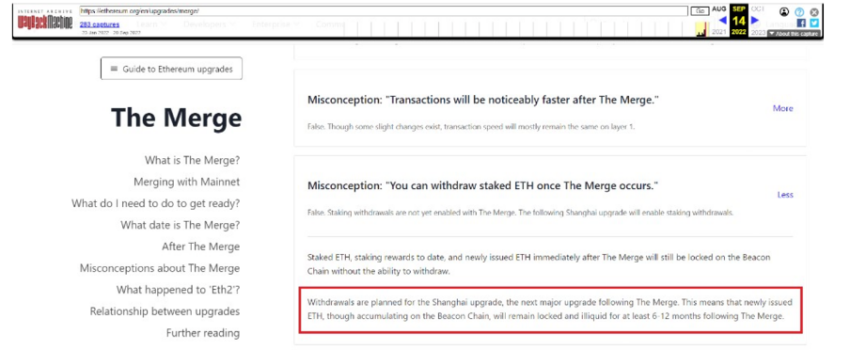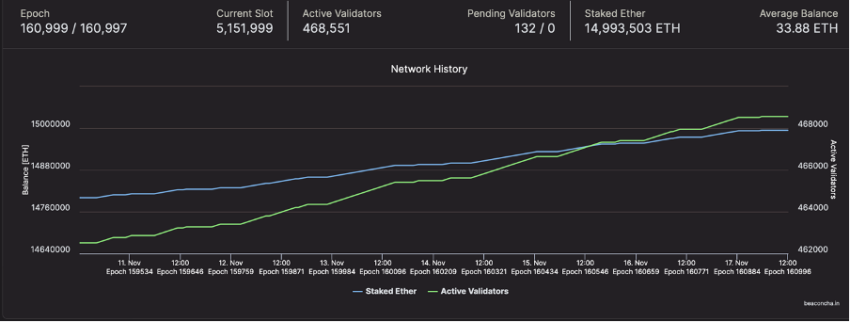Following the Ethereum Merge, staking ETH has become a key component of the blockchain. Many investors chose this option in order to earn free rewards. However, the timeframe in which stakers would be able to withdraw has been completely obfuscated, leaving many wondering what will happen.
Millions of users were successfully able to stake their ETH in the run-up to the blockchain’s transition to proof-of-stake when the Ethereum mainnet merged with the Beacon Chain. Now, users can stake their coins to earn rewards.
But now, almost two months after the Merge, the crypto community is demanding answers. When can users withdraw their staked ETH? Similar questions were raised on Twitter after the Ethereum Foundation removed all definitive timelines from its official website.
What’s the deal with Ethereum staking?
The much-anticipated Ethereum Merge event saw many ETH holders rushing to the network. Critical changes were made to improve network security, speed, efficiency, and scalability. It also incorporated another vital addition: a staking model that would replace the consensus layer’s existing mining process.
Users now had the option to lock up their ETH for a specific period to earn rewards while simultaneously adding to the network’s security and sustainability.
This required users to stake at least 32 ETH to participate in the validating process. However, they could also stake fractional amounts via some cryptocurrency exchanges or pooled staking solutions. Current staking pool platforms include Lido, RockPool, and StakeWise. These pools allow users to “pool” their funds to reach the 32 ETH threshold required to activate a validator client.
Simply speaking, investors who stake more ETH earn more in rewards.
However, it’s been a one-way avenue up to this point. The Ethereum foundation has not provided any means to withdraw at the time of publishing.
Moving the Goalposts
Before the Merge was implemented, a timeline of between six and 12 months was given for opening staked ETH withdrawals following the Ethereum mainnet merging with the Beacon Chain. This information had previously been publicly displayed on the official website of the Ethereum Foundation.
BeInCrypto corroborated these claims via the WayBackMachine, a portal that has more than 700 billion web pages saved over time.

The ‘Shanghai’ upgrade that will bring users the ability to withdraw their ETH keeps getting pushed back. The official website even removed the set timeline and quietly changed its tone regarding withdrawing staked ETH:
Another fellow user later echoed this on Nov. 16:
Flocking to the stake pools
Since staking began, users have locked up nearly 15 million ETH, equivalent to more than $18 billion at the time of press. The total number of ETH staked stood at 14,956,799, with 467,399 unique validators as shown in the graph below:

30.10% of staked ETH is currently controlled by Lido Finance, 13.70% by Coinbase, 7.90% by Kraken, and another 6.40% by Binance. Altogether, more than 60% of staked ETH is held by four entities per data from Dune Analytics.

Staked ETH (stETH) on Lido Finance is held by 126,333 unique wallets, according to Etherescan. Meanwhile, the unique wallets for Coinbase and Binance pools stand at 4,296 and 9,969 respectively.
Deposits earn staking rewards at a rate of 5.30% of invested capital or current APR (Annual Percentage Rate) or APY (Annual Percentage Yield).
Different crypto platforms have even incorporated their ETH staking earn pages, such as Bitstamp.
Are there any risks?
Every attribute within the cryptocurrency domain comes with a caution tag. If you’re a crypto enthusiast, you already know this by now. Similarly, there are risks associated with ETH staking. From being unable to access assets during the lock-up period to potential losses amounting from 1 to 32 staked ETH.
Even though the Ethereum community is building support for unstaking Ether, there is no timeline yet. Hence, users will have to wait for clarity on when they can access their staked ETH.
With billions of dollars worth of digital assets on stake and zero margins for error, all eyes remain on Ethereum core developers to deliver on their promises. That means that over $18 billion worth of ETH currently staked on the network is stuck until Ethereum’s developers add a withdrawal feature.
Developer thoughts
BeInCrypto had reached out to Ethereum core members such as Tim Beiko, ETH founder Vitalik Buterin, and Justin Drake for their comments on this matter.
While the others didn’t reply, Ethereum researcher Justin Drake quickly responded in a short quote. He stated:
“As I see it, withdrawals are high priority and will likely be part of the next hard fork.”
Here he was referring to the upcoming Shanghai upgrade, which is expected to surface in September 2023. Staked ETH withdrawals and lower gas fees were the top priority agenda with the upgrade.
Last month, the testnet version, dubbed Shandong, went live.
Perhaps the most anticipated proposal was EIP-4895, which would immediately allow those who have staked ETH on the Beacon Chain to withdraw their stake and any rewards they have earned over time.
The post Nobody Knows When Ethereum Stakers Will Be Able to Withdraw Their ETH appeared first on BeInCrypto.

 │ Crypto and Blockchain educator (@Dimi_h)
│ Crypto and Blockchain educator (@Dimi_h) 
 :
: